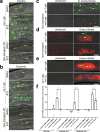The transcription factor ZIP-1 promotes resistance to intracellular infection in Caenorhabditis elegans
- PMID: 35013162
- PMCID: PMC8748929
- DOI: 10.1038/s41467-021-27621-w
The transcription factor ZIP-1 promotes resistance to intracellular infection in Caenorhabditis elegans
Abstract
Defense against intracellular infection has been extensively studied in vertebrate hosts, but less is known about invertebrate hosts; specifically, the transcription factors that induce defense against intracellular intestinal infection in the model nematode Caenorhabditis elegans remain understudied. Two different types of intracellular pathogens that naturally infect the C. elegans intestine are the Orsay virus, which is an RNA virus, and microsporidia, which comprise a phylum of fungal pathogens. Despite their molecular differences, these pathogens induce a common host transcriptional response called the intracellular pathogen response (IPR). Here we show that zip-1 is an IPR regulator that functions downstream of all known IPR-activating and regulatory pathways. zip-1 encodes a putative bZIP transcription factor, and we show that zip-1 controls induction of a subset of genes upon IPR activation. ZIP-1 protein is expressed in the nuclei of intestinal cells, and is at least partially required in the intestine to upregulate IPR gene expression. Importantly, zip-1 promotes resistance to infection by the Orsay virus and by microsporidia in intestinal cells. Altogether, our results indicate that zip-1 represents a central hub for triggers of the IPR, and that this transcription factor has a protective function against intracellular pathogen infection in C. elegans.
© 2022. The Author(s).
Conflict of interest statement
The authors declare no competing interests.
Figures







Similar articles
-
A pals-25 gain-of-function allele triggers systemic resistance against natural pathogens of C. elegans.PLoS Genet. 2022 Oct 3;18(10):e1010314. doi: 10.1371/journal.pgen.1010314. eCollection 2022 Oct. PLoS Genet. 2022. PMID: 36191002 Free PMC article.
-
The Caenorhabditis elegans RIG-I Homolog DRH-1 Mediates the Intracellular Pathogen Response upon Viral Infection.J Virol. 2020 Jan 6;94(2):e01173-19. doi: 10.1128/JVI.01173-19. Print 2020 Jan 6. J Virol. 2020. PMID: 31619561 Free PMC article.
-
The bZIP Transcription Factor ZIP-11 Is Required for the Innate Immune Regulation in Caenorhabditis elegans.Front Immunol. 2021 Nov 5;12:744454. doi: 10.3389/fimmu.2021.744454. eCollection 2021. Front Immunol. 2021. PMID: 34804026 Free PMC article.
-
Caenorhabditis elegans as a model for intracellular pathogen infection.Cell Microbiol. 2013 Aug;15(8):1313-22. doi: 10.1111/cmi.12152. Epub 2013 May 13. Cell Microbiol. 2013. PMID: 23617769 Free PMC article. Review.
-
Insights from C. elegans into Microsporidia Biology and Host-Pathogen Relationships.Exp Suppl. 2022;114:115-136. doi: 10.1007/978-3-030-93306-7_5. Exp Suppl. 2022. PMID: 35544001 Free PMC article. Review.
Cited by
-
Similarities in the induction of the intracellular pathogen response in Caenorhabditis elegans and the type I interferon response in mammals.Bioessays. 2023 Nov;45(11):e2300097. doi: 10.1002/bies.202300097. Epub 2023 Sep 4. Bioessays. 2023. PMID: 37667453 Free PMC article.
-
Adenosine deaminase and deoxyadenosine regulate intracellular immune response in C. elegans.iScience. 2025 Feb 3;28(3):111950. doi: 10.1016/j.isci.2025.111950. eCollection 2025 Mar 21. iScience. 2025. PMID: 40034845 Free PMC article.
-
Diversity-disease relationships in natural microscopic nematode communities.R Soc Open Sci. 2025 Apr 2;12(4):242088. doi: 10.1098/rsos.242088. eCollection 2025 Apr. R Soc Open Sci. 2025. PMID: 40177104 Free PMC article.
-
Microsporidia infection alters C. elegans lipid levels.PLoS One. 2025 Jul 1;20(7):e0327188. doi: 10.1371/journal.pone.0327188. eCollection 2025. PLoS One. 2025. PMID: 40591710 Free PMC article.
-
A pals-25 gain-of-function allele triggers systemic resistance against natural pathogens of C. elegans.PLoS Genet. 2022 Oct 3;18(10):e1010314. doi: 10.1371/journal.pgen.1010314. eCollection 2022 Oct. PLoS Genet. 2022. PMID: 36191002 Free PMC article.
References
-
- Yamada, T. et al. RIG-I triggers a signaling-abortive anti-SARS-CoV-2 defense in human lung cells. Nat. Immunol. 10.1038/s41590-021-00942-0 (2021). - PubMed
Publication types
MeSH terms
Substances
Grants and funding
LinkOut - more resources
Full Text Sources
Molecular Biology Databases

